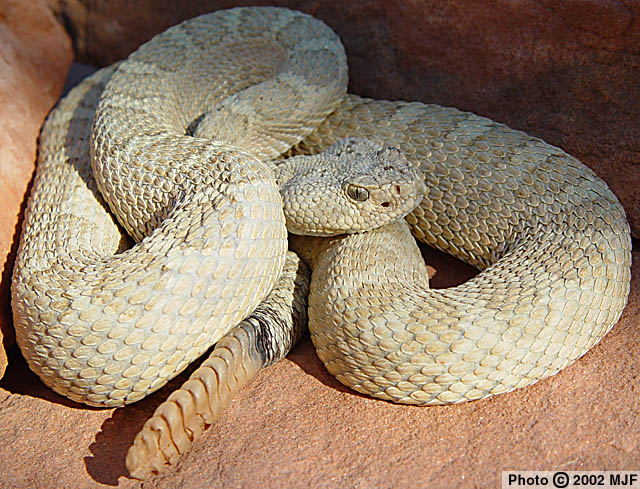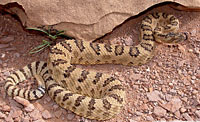Online Field Guide to The Reptiles and Amphibians of Arizona



Crotalus oreganus abyssus, Coconino County, AZ
 C. o. concolor Coconino Co., AZ |
| WESTERN RATTLESNAKE Crotalus oreganus |
Venomous
|
| DESCRIPTION: A medium to large (up to 1,650 mm or 63″ in total length excluding rattle) rattlesnake with highly variable coloration and large dorsal blotches. Coloration can be straw-yellow, tan, pink, salmon, gray, gray-brown, off-white, cream, or olive. The dorsal blotches are usually dark-edged with centers that are only moderately darker than the background color. The blotches narrow and become more like bands near the tail. Dark gray or black rings often mark the tip of the tail. A dark line runs from behind the eye to the corner of the mouth. Blotches can be very faded in adults and some older specimens lack body markings entirely. Young are usually pale gray or tan with dark, distinct dorsal blotches and facial markings. The pupils are vertically elliptical and the dorsal scales are keeled. The neck is slender and the head is broad and triangular. On the end of the tail is a rattle composed of a series of loosely interlocking keratinous sections. A new section is added each time the snake sheds its skin.
DISTRIBUTION: This snake is found in extreme northwestern Arizona. It occurs in the upper Grand Canyon, Marble Canyon, Glen Canyon and associated side canyons as well as on the Arizona Strip (the portion of Arizona north of the Colorado River). Elevation ranges from 1,900′ to ca. 8,000′. HABITAT: Found in a variety of biotic communities in Arizona including Mohave Desertscrub, Great Basin Desertscrub, Great Basin Grassland, and Great Basin conifer Woodland. It inhabits steep and rocky canyons and their tributaries, rolling foothills, high plains, and plateaus. DIET: The Western Rattlesnake feeds on rats, squirrels, mice, lizards, and birds. It uses venom injected through long, hollow, retractable fangs to kill and begin digesting its prey. REPRODUCTION: Young are born in summer. SUBSPECIES FOUND IN AZ: REMARKS: This rattlesnake is capable of delivering large amounts of potent venom. If encountered it should be left alone. A large percentage of envenomations occur when a snake is handled or abused. By Thomas C. Brennan
Brennan, T. C., and A. T. Holycross. 2006. A Field Guide to Amphibians and Reptiles in Arizona. Arizona Game and Fish Department. Phoenix, AZ Brennan, T. C., and A. T. Holycross. 2004 Crotalus oreganus concolor. Geographic Distribution. Herpetological Review 35(2). Fowlie. 1965. The Snakes of Arizona. Azul Quinta Press, Fallbrook, California Lowe, Schwalbe, Johnson. 1986. The Venomous Reptiles of Arizona. Nongame Branch Stebbins. 1985. Western Reptiles and Amphibians. Houghton Mifflin. New York, NY |
|
Visit Partners in Amphibian and Reptile Conservation:


HOME
Copyright © 2023, Arizona Game and Fish Department. All rights reserved.
If you make use of the textual contents of this site in reports, publications, etc. please cite and credit the author(s) and photographer(s). All photos on this website are copyrighted. However, those found in the species account section may be used for any noncommercial scientific, educational, or conservation purposes provided that photographs are not altered and continue to bear the copyright symbol and name of the photographer. Please contact the photographer regarding commercial use of copyrighted photographs.












